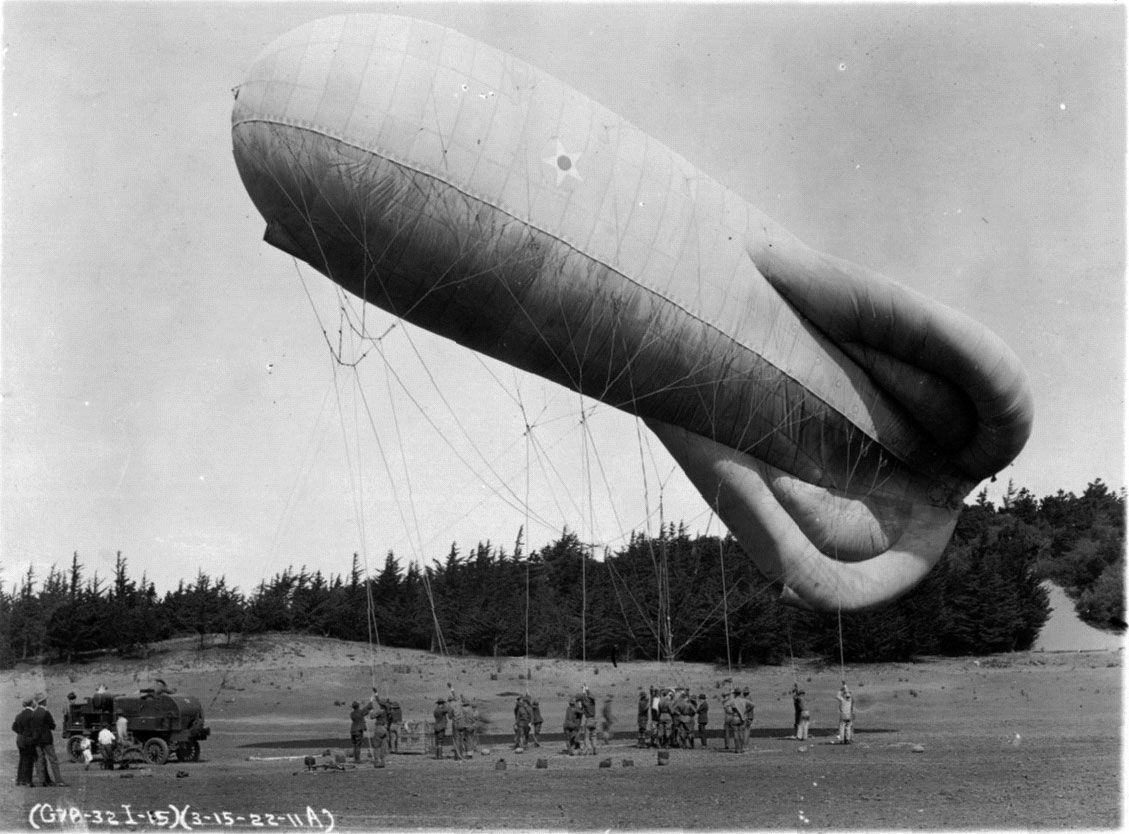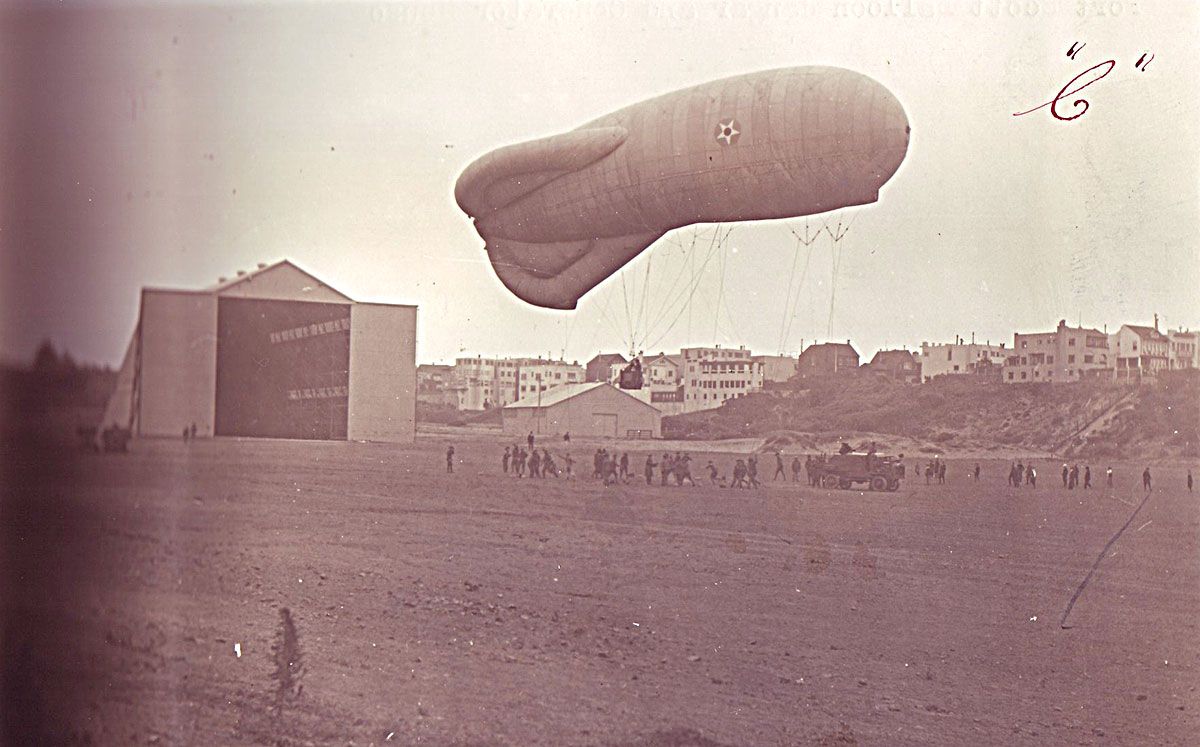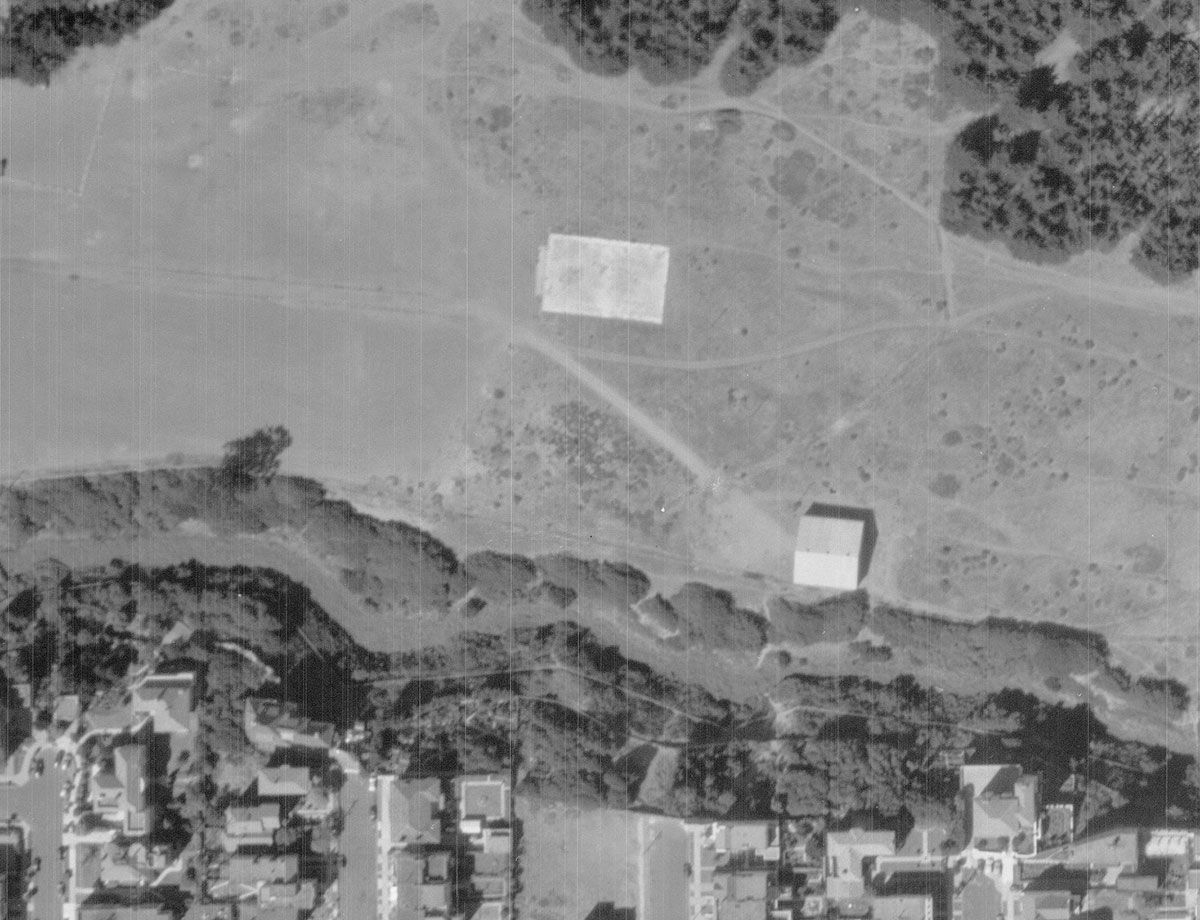Balloons Over the Presidio
Lobos Creek Valley's lighter-than-air days.

China sent a reconnaissance balloon our way in February 2023. Everyone talked about it and then it was shot down. Despite the implications around national security and international relations, it was hard not to raise an eyebrow that the fuss was over… a balloon?
Balloons seem the opposite of high-tech spy stuff (although apparently this balloon lugged more than a couple thousand pounds of high-tech stuff on it). A bulbous air-filled globe doesn’t feel very threatening. One punches balloons. One accidentally pops balloons. One inhales helium from balloons and talks like a chipmunk.
Balloons were cutting-edge tech during the U.S. Civil War and then employed more effectively for strategic reconnaissance in World War I. Observation balloons provided key intelligence on enemy locations and movements over the battlefields of France. And zeppelins equipped with bombs were no joke.
The American expeditionary forces had their own balloon units, succinctly and particularly described on the website of the National World War I Museum and Memorial:
“In total, there were 35 American balloon companies in France during World War I; they ascended 5,866 times, adding up to 6,832 hours in the air. Their balloons were attacked 89 times; 35 burned, 12 were shot down by enemy fire and one floated into enemy lines. Of all 116 parachute jumps from balloons, the parachutes – made of silk – never failed to open, though one observer lost his life when pieces of a burning balloon fell on his descending parachute. The reconnaissance of these balloon observers was invaluable, sighting thousands of instances of enemy planes, infantry and artillery fire.”

Two companies of the United States’ balloon corps were established in the Bay Area after the war. Stationed on the north and south of the Golden Gate, the job of the 14th and 24th Balloon Companies was to assist Coast Artillery by providing target ranging observations for the big guns defending the bay. The San Francisco defenses were the first in the country to use manned balloons with coastal batteries.

In the fall of 1920, the War Department approved standard plans for “Dirigible Balloon Hangars for Aviation Stations” at eight coastal defense locations in Maine, Massachusetts, Washington State, and California, including the Lobos Creek Valley in the Presidio of San Francisco, just east of Baker Beach. Researcher (and friend) John Martini lays out the specifications for each hangar complex:
“…a steel hangar covered with galvanized iron, 120 by 76 feet, rising to an elevation of 60 feet; a generator house of steel construction on a concrete foundation, 80 feet square; a frame storehouse, 30 by 70 feet; and a frame garage 30 by 60 feet. In addition, each group of buildings required six acres of surrounding land, much of it for use as a landing field and staging area for the ground support and mooring equipment.”
Below is the Lobos Creek Valley hanger for the 14th Balloon company of the U.S. Army Air Service (precursor to today’s U.S. Air Force.). It was big enough to house both a hydrogen-inflated “Type C3” observation balloon—which looks a little like a blimp to the uneducated eye and was meant to be secured by cable to the ground (tethered) while in use —as well as a smaller spherical “free” (untethered) balloon, which the observation pilot had to control. The 24th Balloon Company had a similar hangar built at Fort Baker in Marin County.

The guys took a lot of stuff up in their baskets. A shortened list prescribed by the U.S. Army included field glasses, photographs of the landscape, maps on roller boards, pencils, cleaning clothes, a compass, a hand anemometer (measures wind speed), an altimeter (measures altitude), a thermometer, a reel of telephone wire (yes, they had a long-corded telephone with which they communicated), and signal flags in case the phone broke.

These balloon outfits ended up having a short existence. It was dangerous work hanging high in the air under a bag of highly flammable hydrogen gas hoping the wind didn’t pick up. With advances in radio communications, planes quickly began taking over artillery spotting duties.
Officially, the balloon corps were terminated in 1937. In World War II, unmanned “barrage balloons” were used defensively to impede the path of incoming enemy planes, and that was about it.
In a 1938 aerial photograph, just the concrete pad of the Lobos Creek Valley hangar remains and sometime between then and a 1948 aerial the attendant storehouse or generator building was demolished.


As China recently showed, balloons are making a comeback. According to the Army Times, the U.S. is planning “a high-altitude intelligence, cyber and electronic warfare sensor that can fly above enemy territory to provide data and potentially jamming or disruption capability.”—a sensor being a solar-powered glider or balloon.
My daily get-out-of-the-house walk (described in one of my previous Grab Bag posts) takes me through the Lobos Creek Valley. While there are still old military and park maintenance buildings, most of it is a restored dune environment with a great pedestrian boardwalk.
The sky above is usually occupied by wheeling hawks and ravens.

Woody Beer and Coffee Fund

Great thanks to Pat C. for making sure I have something to sip with friends by his donation to the not-a-charity Woody Beer and Coffee Fund. What is life without a beverage at hand? I think most of my waking hours there's a vessel of water, tea, coffee, wine, or beer in use: my liquid assets, so to speak.
Help build up the reservoir. Then hit me up to buy you a beverage of your choice. Or switch that sequence, if you like!
Sources
Erwin N. Thompson, Defender of the Gate: The Presidio of San Francisco, A History from 1846 to 1995 (Historic Resource Study Volume II, National Park Service, Golden Gate National Recreation Area, July 1997), pgs. 561–564.
Work of the Observer (Washington, D.C.: Division of the Military Aeronautics, U.S. Army, 1918)

